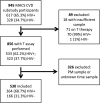Morning free and total testosterone in HIV-infected men: implications for the assessment of hypogonadism
- PMID: 24450960
- PMCID: PMC3900935
- DOI: 10.1186/1742-6405-11-6
Morning free and total testosterone in HIV-infected men: implications for the assessment of hypogonadism
Abstract
Background: Hypogonadism is common among HIV-infected men, even among men receiving antiretroviral therapy (ART). Our objective in this study was to determine the prevalence of biochemical hypogonadism among HIV-infected men compared with HIV-uninfected controls. We also examined the use of free testosterone (FT) and total testosterone (TT) measurements in the assessment of biochemical hypogonadism in HIV-infected and -uninfected men.
Methods: This was a cross-sectional analysis from the Multicenter AIDS Cohort Study (MACS). TT levels were measured from archived serum using liquid chromatography-tandem mass spectrometry. FT was calculated from TT and sex hormone-binding globulin (SHBG) (measured by radioimmunoassay) using the Vermeulen equation. Biochemical hypogonadism was defined as having low TT, low FT, or both.
Results: Of 945 men in the MACS Cardiovascular Substudy, T assays were not performed in 89 because of insufficient/no stored serum (n = 18) or use of T replacement therapy (TRT) (n = 71). 530 men had morning (AM) T measurements; 364 (68.7%) were HIV-infected. The prevalence of biochemical hypogonadism was similar in HIV-infected (34/364 = 9.3%) and HIV-uninfected (12/166 = 7.2%) men. Prevalence of hypogonadism, when men on TRT (n = 71) were included in the group of hypogonadal men, was higher in HIV-infected (104/434 = 24.0%) compared with HIV-uninfected (13/167 = 7.8%) men (p < 0.0001). Of 34 HIV-infected men with biochemical hypogonadism not on TRT, 11 (32.4%) had normal TT, but low FT. Of 12 HIV-uninfected men with biochemical hypogonadism not on TRT, none were in this category (p = 0.04) - all had low TT.
Conclusions: The prevalence of biochemical hypogonadism in our sample of HIV-infected men was approximately 10%, with a substantial proportion of these men having a normal TT, but low FT. The measurement of AM FT, rather than TT, in the assessment of hypogonadism in HIV-infected men will likely increase diagnostic sensitivity and should be recommended.
Figures
References
-
- Wunder DM, Bersinger NA, Fux CA, Mueller NJ, Hirschel B, Cavassini M, Elzi L, Schmid P, Bernasconi E, Mueller B, Furrer H, Swiss HIV. Cohort study: hypogonadism in HIV-1-infected men is common and does not resolve during antiretroviral therapy. Antivir Ther. 2007;11:261–265. - PubMed
-
- Rietschel P, Corcoran C, Stanley T, Basgoz N, Klibanski A, Grinspoon S. Prevalence of hypogonadism among men with weight loss related to human immunodeficiency virus infection who were receiving highly active antiretroviral therapy. Clin Infect Dis. 2000;11:1240–1244. - PubMed
-
- Grinspoon S, Corcoran C, Lee K, Burrows B, Hubbard J, Katznelson L, Walsh M, Guccione A, Cannan J, Heller H, Basgoz N, Klibanski A. Loss of lean body and muscle mass correlates with androgen levels in hypogonadal men with acquired immunodeficiency syndrome and wasting. J Clin Endocrinol Metab. 1996;11:4051–4058. - PubMed
-
- Grinspoon S. Androgen deficiency and HIV infection. Clin Infect Dis. 2005;11:1804–1805. - PubMed
Grants and funding
LinkOut - more resources
Full Text Sources
Other Literature Sources
Miscellaneous



